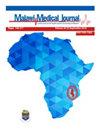尼日利亚西南部皮肤癌的临床流行病学概况
IF 1.2
4区 医学
Q4 PUBLIC, ENVIRONMENTAL & OCCUPATIONAL HEALTH
引用次数: 0
摘要
背景皮肤癌是最常见的癌症之一。白种人和非洲人的皮肤癌发病率呈上升趋势,但在发病模式上存在显著差异。本研究旨在评估尼日利亚西南部伊巴丹的皮肤癌发病模式。研究的目的是确定风险因素和发病模式。研究采用数据提取表,从 2001 年 1 月至 2010 年 12 月期间皮肤癌组织学诊断患者的医院记录中获取信息。研究在尼日利亚伊巴丹大学学院医院放射肿瘤科进行。患者年龄在 7 至 98 岁之间,平均年龄为 46.6 岁。男女比例为 1.5:1。发病高峰年龄在 40 至 49 岁之间。在风险因素中,最常见的是外伤(18.3%)和白化病(15.9%)。鳞状细胞癌(63%)是最常见的组织学亚型。大多数受访者的癌症处于局部晚期(43.7%)和转移期(22.2%)。下肢(59.9%)和头颈部(22.0%)是最常受影响的部位。肺部(46.4%)是最常见的远处转移部位,其次是肝脏(21.4%),而脑部(7.1%)是最不常见的转移部位。本文章由计算机程序翻译,如有差异,请以英文原文为准。
Clinico-epidemiological profile of skin cancer in South Western Nigeria
BackgroundSkin cancer is one of the most common forms of cancer. The incidence of skin cancer is on the increase among Caucasians and Africans, though there are significant differences in the pattern of presentation. This study sought to evaluate the pattern of skin cancer presentation in Ibadan, south-west Nigeria. The objective of the study was to determine the risk factors and pattern of presentation.MethodsData extraction forms were used to obtain information from the hospital records of patients with histological diagnoses of skin cancer between January 2001 and December 2010. The study took place at the Radiation Oncology Department, University College Hospital, Ibadan, Nigeria.ResultsA total of 126 cases were identified. The age range of patients was from 7 to 98 years, with a mean age of 46.6 years. The male-to-female ratio was 1.5:1. The peak age of incidence was between 40 and 49 years old. Of the risk factors, trauma (18.3%) and albinism (15.9%) were the most common. Squamous cell carcinoma (63%) was the most common histological sub-type recorded. The majority of the respondents presented with locally advanced (43.7%) and metastatic (22.2%) stages. The lower limb (59.9%) and head and neck region (22.0%) were the most commonly affected sites. The lungs (46.4%) were the most common site of distant metastases, followed by the liver (21.4%), and the brain (7.1%) was the least common site of metastasis.ConclusionThe finding that majority of the respondents in this study presented with locally advanced and metastatic disease buttresses the need for public awareness programs to ensure uptake of preventive measures by the populace and emphasizes the need for early presentation.
求助全文
通过发布文献求助,成功后即可免费获取论文全文。
去求助
来源期刊

Malawi Medical Journal
Medicine-General Medicine
CiteScore
1.50
自引率
0.00%
发文量
27
审稿时长
>12 weeks
期刊介绍:
Driven and guided by the priorities articulated in the Malawi National Health Research Agenda, the Malawi Medical Journal publishes original research, short reports, case reports, viewpoints, insightful editorials and commentaries that are of high quality, informative and applicable to the Malawian and sub-Saharan Africa regions. Our particular interest is to publish evidence-based research that impacts and informs national health policies and medical practice in Malawi and the broader region.
Topics covered in the journal include, but are not limited to:
- Communicable diseases (HIV and AIDS, Malaria, TB, etc.)
- Non-communicable diseases (Cardiovascular diseases, cancer, diabetes, etc.)
- Sexual and Reproductive Health (Adolescent health, education, pregnancy and abortion, STDs and HIV and AIDS, etc.)
- Mental health
- Environmental health
- Nutrition
- Health systems and health policy (Leadership, ethics, and governance)
- Community systems strengthening research
- Injury, trauma, and surgical disorders
 求助内容:
求助内容: 应助结果提醒方式:
应助结果提醒方式:


